|
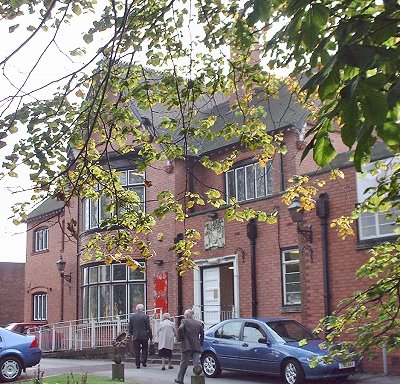
Listing: Locally listed in 2004. Built in 1905 as a
private residence, this house became the the town's Library, Museum and Art
Gallery in 1937 and this use continues. Many original features of the red
brick building with terracotta remain. The large curved bay windows on the
ground floor and first floor are particularly attractive as are the stained
glass windows. This is a landmark building which contributes greatly to
the Mount Pleasant townscape.
Comment: The original house on this site was called
Brueton House. The Bruetons were a family of lock makers, the business
having been started about 1790 by William and Mary Brueton. They seem to
have acquired the land on which this house now stands. On their deaths the
business and land passed to their children, Thomas, Elizabeth, Sara and Maria.
Thomas died in 1844 but his wife, Sophia, lived until 1871. The lock
making firm merged with John Harper & Co. of Willenhall in 1852, at which
time the house which was by then on this site passed to John Harper. He
lived in the old house until he died in 1903. By this time John Harper and
Co., who had started out as lock makers, were already well on the way to being
the large and diverse manufacturing foundry they became. On John Harper's
death the estate was inherited by his son Frederick Harper, who demolished the
original house and built this one, retaining the name. The design of the
house is very much of its time and probably qualifies as being Arts and Crafts.
The house is still known as Brueton House by many Bilstonians.
|
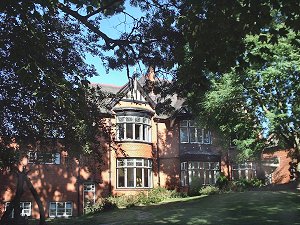 Brueton House from the back garden.
Brueton House from the back garden. |
In 1918 the building was taken over by the Bilston Girl's
High School which had just been set up as a private school. In
1919 it was taken over by the Staffordshire County Council.
The school left for new and much bigger premises in 1930 but it is
probably to their occupation that the extensive additions to the
building can be attributed. Old pupils of the school remember the
large room (to the right of the photo above) as a gymnasium. |
What happened here from 1930 to 1937 is not clear but it might
have taken some time for the school to make their transfer. In 1937 it was
Bilston Borough Council who opened it as a museum, art gallery, reading rooms
and library, and it is their arms which appear above the door. Previously
the town library and all the other facilities had been in the Town Hall.
This new scheme was helped along by William Thompson (then of Colwyn Bay but
formerly of Bilston) who gave £1,000 and a collection of pictures. During World
War 2 the cellars were used as am air raid shelter. Brain Fowler, who then
lived opposite at 52 Mount Pleasant, remembers that the access to them was by
the steps at the front of the building, which were, at that time, covered by a
trap door.
| Since the local government re-organisation of 1966 the
building has been owned and operated by Wolverhampton Borough Council.
In the early 1990s they re-organised their three museums and art
galleries, with the the Wolverhampton Art Gallery taking fine art,
Bantock House taking local history and Brueton House taking crafts, for
which it is a regional rather than a city gallery.
This activity extends to the garden at the back where a number of
sculptures are displayed. The library continues to use the old
gymnasium. |
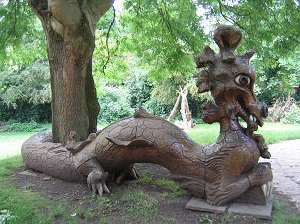
Many school children visit the
gallery to do craft work. This cheerful dragon, carved from wood,
is a great favourite with them. |
Under this arrangement the museum function of Brueton House
effectively ceased and such items as the Bilston enamels were removed, to the
great indignation of the local populace. In 2003 the craft gallery got
funding to turn one of its large galleries into a Craftsense exhibition, which
duly opened in 2005. This exhibition covers the industrial crafts of the
region and interestingly juxtaposes old examples of various crafts and modern
examples of hand craft work in the same materials. The exhibition (which
is a permanent one) also lead to the return of the enamels to Bilston, to the
great satisfaction of the local populace. This display, and that still
shown at Bantock House, along with the reserve collection, form the biggest
collection of enamels other than that in the Victoria and Albert Museum.
(Presumably Thompson's pictures, along with others, are now somewhere in the
vaults of the Wolverhampton Art Gallery).
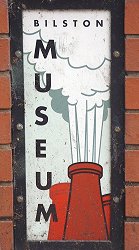 |
The panel (left) on one of
the gateposts; and the rainwater hopper (right) on the front facade, are intended to refer to the Bilston Steel Works. They remain from
the days of Bilston Museum. |
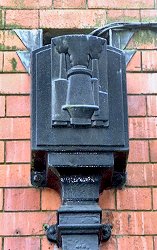 |
Thanks to Reg Aston for much of the above information; and
to Emma Daker for some additional information about the building's history.

|